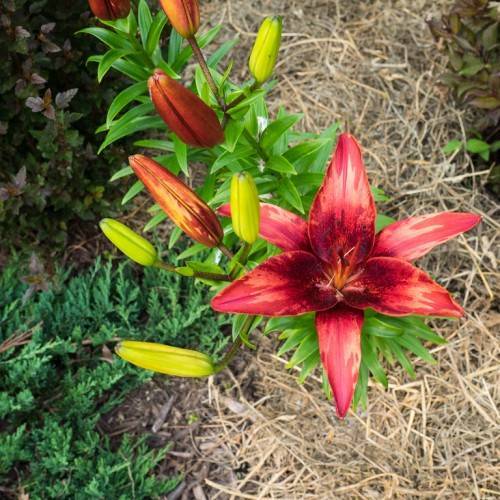
Asiatic lily
Lilium 'Commander In Chief'
Cycle:
Perennial
Watering:
Average
Hardiness Zone:
4 - 8
Flowers:
Flowers
Sun:
Full sun,part shade
Leaf:
Yes
Growth Rate:
High
Maintenance:
Low
watering
Asiatic lilies (Lilium 'Commander In Chief') require regular watering, but don't like to remain saturated in water. Aim to water your lilies about once per week, providing 1-2 inches of water when you do. Typically during summer this is best done in the morning, while in spring and fall mid afternoon is preferred. Make sure the soil has dried out a bit in between waterings and always check the top 2-3 inches of soil to determine when it needs water. If your soil is dry, provide water slowly and evenly to the base of the lily.
sunlight
Asiatic lilies (Lilium ‘Commander in Chief’) require full sun for the best flowering and vigor. This means planting them in a spot with at least 6-8 hours of direct sunlight each day. Some morning sun is fine but too much afternoon sun can cause the flowers to be less full. Aim to provide your lilies with as much sun as possible throughout the day without more than 4-5 hours of direct afternoon sunlight.
pruning
Asiatic lily (Lilium 'Commander In Chief') should be pruned immediately after the flowers have wilted and gone to seed. Pruning should be done gently as it is a lily bulb and the flower is quite delicate. To prune lilies, use long-handled, sharp secateurs or a knife and remove spent flowerheads. Cut stems of the flower head down to the basal foliage or bulb. This is usually done during the summer/early fall. When pruning, remove all faded, discolored, and dead leaves. If there are any damage stems it is best to remove them too. If the lily is not flowering well, aggressively cutting back the stems can help to rejuvenate the plant. Aim for removing about 1-third of the total growth. This will encourage stronger stems for the following season.
